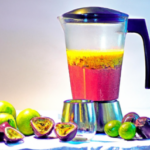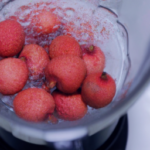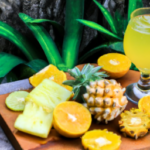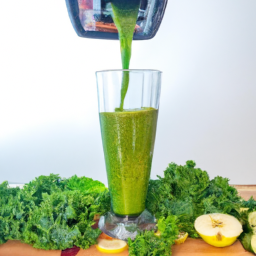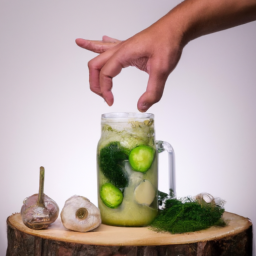On a hot summer day, my friends and I were craving a refreshing drink to cool down. We stumbled upon a recipe for Hippie Juice, and ever since then, we have been hooked on it.
Hippie Juice is a fruity, sweet concoction that’s perfect for any occasion – whether it’s a backyard BBQ or a day at the beach. In this article, I’ll share with you my recipe for Hippie Juice, along with some tips for serving and variations you can try. But first, let’s talk about what Hippie Juice actually is and what you’ll need to make it.
Get ready for a burst of fruity flavors that will have you feeling like you’re at Woodstock all over again!
Key Takeaways
- Hippie Juice is a fruity and sweet drink popular among the hippie community, often served at music festivals and outdoor gatherings.
- The drink has a sweet and tangy taste that can be customized, and is loaded with vitamins and antioxidants, making it a hydrating option.
- The ingredients for Hippie Juice include watermelon, pineapple juice, Malibu Rum, Triple Sec, and Lemon-Lime Soda.
- The recipe is easy to follow and can be adjusted based on personal preferences or using different fruits and swapping lemon-lime soda for ginger ale.
What is Hippie Juice? A Brief Introduction
So, you’re curious about what hippie juice is, huh? Well, let me give you a quick rundown.
Hippie juice is a refreshing and fruity drink that is perfect for any occasion. It’s a popular drink among the hippie community and is often served at music festivals and outdoor gatherings. The drink is known for its sweet and tangy taste, and it’s incredibly easy to customize to your taste preferences.
There are numerous benefits to drinking hippie juice. It’s loaded with vitamins and antioxidants, making it a healthy choice for anyone looking to boost their immune system. Additionally, the drink is incredibly hydrating, making it perfect for those hot summer days.
The best part about hippie juice is that you can easily customize it to suit your taste preferences. Whether you prefer a sweeter or tangier taste, you can adjust the ingredients to create the perfect blend.
So, let’s get started with the ingredients you’ll need.
Ingredients You Will Need
To whip up this refreshing drink, you’ll need a few simple ingredients that are probably already in your kitchen! Here’s a breakdown of what you’ll need:
| Ingredient | Amount |
|---|---|
| Watermelon | 2 cups |
| Pineapple Juice | 2 cups |
| Malibu Rum | 1 cup |
| Triple Sec | 1 cup |
| Lemon-Lime Soda | 2 cups |
To prepare the fruits, start by cutting up your watermelon into small cubes. If you’re using fresh pineapple, you’ll need to cut off the skin and core before blending it into juice. Alternatively, you can use pre-made pineapple juice from the store. Once your fruits are prepped and ready, you can move onto the blending techniques to create the perfect Hippie Juice.
Preparing the Fruits
First things first, you’re going to need to get those fruits prepped and ready for blending. Choosing the right fruits is key to ensuring your hippie juice is packed with flavor and nutrients. I recommend selecting ripe watermelon and pineapple, as well as fresh strawberries and oranges.
Preparing the fruits in advance will save you time and make the blending process a breeze. Once you have your fruits on hand, it’s time to start chopping. You’ll want to chop up that watermelon into tiny, bite-sized pieces that will explode with flavor in your mouth. And don’t be afraid to get a little wild with that pineapple – you’ll want to cut off that rough exterior and core and slice it up into small chunks that will blend perfectly with the other ingredients.
Remember, the more care you put into preparing your fruits, the better your hippie juice will taste. So let’s get those fruits chopped and ready for blending! Next up, we’ll dive into the blending process and create the ultimate hippie juice.
Making the Juice
Now it’s time to blend all those deliciously chopped fruits together into a vibrant and refreshing beverage that will make your taste buds dance with joy. To start, I like to add the watermelon, strawberries, and pineapples into the blender first. These fruits are naturally more watery and will help create a smooth juice consistency.
Next, I add in the frozen lemonade concentrate and a splash of triple sec to give the juice a tangy kick. When blending, I like to start on a low speed and gradually increase it to ensure all the fruits are fully blended together. If the juice consistency is too thick, I add in a bit of water to thin it out. Once everything is blended together, I pour the juice into a large pitcher and let it chill in the fridge for a few hours before serving.
To add a touch of fun and creativity to your hippie juice, try incorporating a colorful and playful table like the one below:
| Ingredient | Purpose | Emotion |
|---|---|---|
| Watermelon | Sweetness | Delight |
| Pineapple | Tartness | Excitement |
| Strawberries | Freshness | Joy |
| Lemonade Concentrate | Tanginess | Zest |
| Triple Sec | Kick | Fun |
Now that we’ve made the juice, it’s time to think about how to serve it in a way that will make your guests feel special.
Tips for Serving Hippie Juice
When it comes to serving hippie juice, there are a few tips to keep in mind to make sure your guests enjoy it to the fullest.
First, chill the juice before serving it to keep it refreshing and cool.
Secondly, add some ice to the mason jar to keep the drink cold and enhance its taste.
Finally, garnish the jar with some freshly cut fruits to add a pop of color and flavor.
Trust me, serving hippie juice in a chilled mason jar with ice and fruits will make it a crowd-pleaser at any party.
Chill the Juice
Make sure you chill the juice before serving to enhance the refreshing taste. Chilling the juice has numerous benefits, including improving the consistency of the drink, making it more pleasant to drink, and helping to preserve the quality of the juice. There are alternative ways to cool drinks, such as freezing the juice in ice cube trays or placing the juice in a cooler with ice packs. However, the most effective way to chill the juice is to put it in the refrigerator for a few hours before serving.
To ensure that the juice stays cold during your gathering, you can use a table with two columns and four rows to create a drink station. In the first column, place the chilled juice in a large dispenser with a spigot. In the second column, place a variety of cups and glasses for guests to choose from. In the third column, place a bowl of sliced fruit that complements the flavors of the juice. Finally, in the fourth column, place a bucket filled with ice so guests can add some ice to their cups if they prefer their drinks even colder. By following these tips, you can create a fun and refreshing drink station that will keep your guests cool and happy.
Add Some Ice
Who doesn’t love a drink with some extra ice to make it super refreshing and icy cold? Adding ice to your hippie juice is a crucial step to enhance the flavor and make it more enjoyable.
Here are some different types of ice you can use to make your hippie juice:
- Crushed ice: This is perfect for blending into the juice and creating a slushy-like texture.
- Cubed ice: A classic choice for adding to any drink, cubed ice will keep your juice cold without melting too quickly.
- Ice balls: These are great for serving in a glass of hippie juice as they take longer to melt and won’t water down the drink as quickly.
- Flavored ice: Infuse your ice with fruit or herbs that complement the flavors in your hippie juice for an extra burst of flavor.
- Dry ice: For a fun and unique presentation, add a small piece of dry ice to your hippie juice to create a smoking effect.
Using ice in hippie juice not only keeps it cold but also adds texture and enhances the overall drinking experience. Once you’ve added your ice, it’s time to move on to the next step of garnishing with fruits.
Fresh fruits and hippie juice go hand in hand, and garnishing your drink with some colorful and delicious fruits will make it even more appetizing.
Garnish with Fruits
Adding fresh fruits to your hippie juice will not only make it look appealing but also enhance its flavor and aroma. The type of fruits you select for your hippie juice can vary depending on your personal preference. Some popular fruits that are commonly used in hippie juice include strawberries, raspberries, blackberries, blueberries, pineapples, oranges, and lemons. You can either use a single fruit or a combination of fruits to give your hippie juice a unique taste.
To make your hippie juice look more presentable, you can use different presentation ideas. One idea is to cut the fruits into small pieces and place them in a separate bowl. You can also use a skewer to thread the fruits and place them on the rim of the mason jar. Another idea is to use a fruit-shaped cookie cutter to cut the fruits into different shapes and place them on top of the juice. By using these presentation ideas, your hippie juice will not only taste great but also look visually appealing.
Now that your hippie juice is complete with fresh fruits and a unique presentation, it’s time to serve it in a mason jar.
Serve in a Mason Jar
Now that we’ve garnished our hippie juice with a variety of fruits, it’s time to think about presentation. One of the best ways to serve your hippie juice is in a mason jar. Not only does it give a rustic and vintage feel, but it also adds a touch of creativity to your presentation.
Mason jars are versatile and can be easily decorated to match any occasion. Here are some creative presentation ideas for serving hippie juice in a mason jar:
- Tie a colorful ribbon or twine around the rim of the jar
- Add a personalized label or tag with the name of the drink or event
- Use a decorative straw or spoon to stir and drink the juice
- Fill the jar with ice and add slices of fruit for an extra pop of color and flavor
Of course, if you don’t have mason jars on hand, there are plenty of other alternatives to choose from. Try using a colorful tumbler or a vintage glass bottle to give your hippie juice a unique touch. Whatever you choose, the key is to have fun with it and let your creativity shine.
Moving on to variations of hippie juice, there are endless possibilities to explore. From adding different types of alcohol to experimenting with new fruit combinations, the options are endless. Let’s dive in and see how we can take our hippie juice to the next level.
Variations of Hippie Juice
So, I was wondering if I can prepare Hippie Juice in advance? Can I make a large batch and store it for later use?
Also, I was thinking if I can experiment with different fruits and create new variations of the drink?
Lastly, how many servings will the recipe for Hippie Juice make? These are some questions that popped up in my mind, and I’m curious to explore the answers.
Can I Make Hippie Juice in Advance?
If you’re looking to save time, you’ll be happy to know that Hippie Juice can easily be prepared in advance, allowing all the flavors to meld together for a more delicious drink experience. Here are a few tips for making Hippie Juice in bulk and storing it for later use:
-
Choose a large container with a lid: You’ll need a container that can hold all your ingredients and is easy to store in your fridge. A large pitcher or mason jar will work well.
-
Mix your ingredients together: Follow the recipe for Hippie Juice and mix all your ingredients together in your chosen container. Make sure everything is well combined and there are no clumps of sugar or fruit.
-
Chill in the fridge: Once your Hippie Juice is mixed, cover the container and place it in the fridge. Allow it to chill for at least a few hours, but preferably overnight, to allow all the flavors to meld together.
-
Serve and enjoy: When you’re ready to serve your Hippie Juice, give it a good stir and pour it over ice. You can garnish with additional fruit or herbs to add some extra flair to your drink.
Now that you know how easy it is to make Hippie Juice in advance, you may be wondering if you can use different fruits to switch up the flavors. Let’s explore this topic in more detail.
Can I Use Different Fruits?
To switch up the flavor of your fruity drink, you can easily swap out the fruits in the recipe and create a unique concoction that suits your taste buds. The original recipe calls for strawberries, lemons, watermelon, and pineapple, but you can experiment with different fruit combinations like blueberries, raspberries, or even mangoes.
Using fresh fruits is always the best option as they’re packed with vitamins and minerals that your body needs. Plus, fresh fruits add a burst of natural sweetness to your drink, making it more delicious and healthy.
Aside from the taste, using different fruits also gives you a chance to explore the health benefits they offer. For example, adding blueberries to your hippie juice can boost your immune system, while raspberries are rich in antioxidants that help protect your cells from damage.
By using different fruits, you can create a drink that not only quenches your thirst but also provides your body with essential nutrients.
Now, let’s move on to the next section and find out how many servings this recipe will make.
How Many Servings Will This Recipe Make?
You’re probably wondering how much of this fruity goodness you can indulge in, and lucky for you, this recipe yields several servings to share with your friends or keep all to yourself. Depending on the serving size, you can expect to get about 8-10 servings out of this recipe.
If you’re serving this at a party or gathering, you can make smaller servings and stretch it out to serve more people. Alternatively, if you’re making this for personal enjoyment, you can make larger servings and indulge to your heart’s content. With this recipe, you have the flexibility to choose your serving size options.
Now that you know how many servings this recipe makes, let’s move on to the next section about the ‘hippie juice recipe card’.
Hippie Juice Recipe Card
Get ready to whip up some delicious Hippie Juice with this easy-to-follow recipe card! This recipe makes a pitcher of Hippie Juice that’s perfect for sharing with friends and family.
However, if you need to make adjustments to the serving size, it’s easy to do so by simply adjusting the ingredient quantities accordingly.
There are also variations of Hippie Juice that you can experiment with. For example, you can swap out the lemon-lime soda for ginger ale or add in some fresh fruit like sliced strawberries or peaches.
The possibilities are endless, and you can make this recipe your own by adding your own unique twist. So, grab your ingredients and let’s get started on making some delicious Hippie Juice!
Now that you have the recipe card and some ideas for variations, it’s time to gather your ingredients and get started. But before you do, let’s take a look at some references and resources that can help you perfect your Hippie Juice recipe.
References and Resources
Looking to perfect your pitcher of Hippie Juice? Check out these helpful references and resources! Whether you’re a seasoned mixologist or a beginner, these tips and tricks will help you create the perfect blend of flavors for your Hippie Juice.
-
Benefits of drinking fruit juice: Drinking fruit juice is a great way to stay hydrated and get essential vitamins and nutrients. Fruit juice can also boost your immune system and help prevent chronic diseases.
-
Different ways to serve fruit juice: Fruit juice can be served over ice, blended into smoothies, or mixed with other beverages for a refreshing and flavorful drink. You can also add fresh fruit or herbs for an extra touch of flavor.
-
Recipe variations: There are many variations of the Hippie Juice recipe, so don’t be afraid to experiment with different fruits and flavors. Try adding pineapple or mango for a tropical twist, or swap out the lemon-lime soda for sparkling water for a lighter option.
-
Helpful resources: There are many websites and blogs dedicated to fruit juices and smoothies, such as BlenderBabes.com or TheSmoothieBible.com. These resources offer recipes, tips and tricks, and product reviews to help you perfect your Hippie Juice and other fruit juice blends.
Frequently Asked Questions
What are some common substitutions for the ingredients in hippie juice?
Ingredient alternatives abound for hippie juice. Vegan options include coconut milk, agave nectar, and pineapple juice. Just because one ingredient is missing doesn’t mean the whole recipe is ruined. Experiment and enjoy!
How long can hippie juice be stored in the refrigerator?
Hippie juice can be stored in the refrigerator for up to 3 days. Its shelf life may vary depending on the ingredients used. Properly sealed containers and keeping it at a consistent temperature can help extend its freshness.
Can you make hippie juice without alcohol?
Mocktail alternatives to hippie juice can be made without alcohol, using fresh fruits and juices. These drinks offer health benefits like hydration and vitamin intake while still providing a fun and flavorful experience.
How many servings does the hippie juice recipe make?
When it comes to servings, the hippie juice recipe can easily be adjusted to make more or less depending on your needs. Some possible discussion ideas include tweaking the recipe quantities or serving size recommendations to suit your preferences.
What are some common garnishes or decorations for serving hippie juice?
For a fun and festive presentation, I like to add fruit options like sliced strawberries, oranges, and lemons to my hippie juice. You can also serve it in a mason jar with a colorful paper straw and a slice of watermelon as a garnish.
Conclusion
Well, hippies, it looks like we’ve reached the end of this groovy guide on how to make some delicious hippie juice. If you followed along with me, you should now have a refreshing drink that’s sure to transport you back to the 1960s.
But wait, there’s more! If you really want to take your hippie juice game to the next level, try experimenting with different fruits and juices. Mix things up and see what kind of wild concoctions you can come up with. Who knows, you might just stumble upon the next big thing in the world of hippie beverages.
So go forth, my fellow flower children, and let your creativity run wild. And if anyone tries to tell you that hippie juice isn’t a real thing, just smile and offer them a glass. Trust me, they’ll be singing a different tune once they taste the magic that’s hippie juice.
Peace out!
Ilana has been a vegan for over 10 years. She originally made the switch for health reasons, but soon found herself becoming more and more passionate about the ethical and environmental implications of a vegan lifestyle. Ilana is the author of The Graceful Kitchen, a blog all about veganism. She loves to cook up delicious and nutritious vegan meals, and share her recipes with others who are interested in leading a cruelty-free life. Ilana is also a strong advocate for using whole foods as the foundation of a healthy diet, and believes that going vegan is one of the best ways to achieve this.





